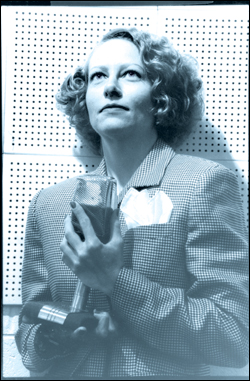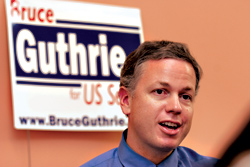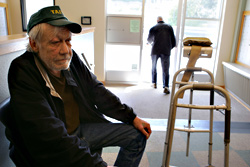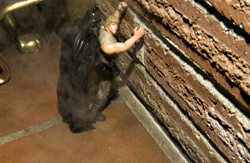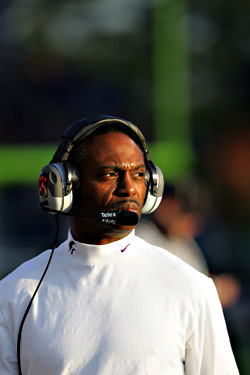CYNTHIA DOYON meant business the morning of Aug. 5. She was cleaning out her desk at KUOW-FM and moving on after 24 years at the NPR station. The 48-year-old with a smooth, husky voice had been working part time on weekends as the host of The Swing Years and Beyond. For photographs, she dressed like a 1940s throwback?checked jackets and skirts, permed blond hair carefully parted to the side. Around the University of Washington campus, however, she was most commonly seen walking to the library wearing khakis and a windbreaker, Schlitz beer cap on her head, books in her arms.
Many thousands in the Seattle area spent Saturday nights with Doyon. They had a relationship. She was the unseen, friendly, soothing guide taking listeners back to a time when the world didn’t seem so rough, when Glenn Miller ruled the airwaves and people dressed up for a walk to the corner store, when radio had an allure as the dominant mass medium. But when she signed off the previous Sunday, Doyon didn’t mention her pending departure to her loyal audience. Nor, on this Tuesday morning, did she visit the announcer’s booth to say goodbye to Deborah Brandt, who was hosting the local segments of Morning Edition.
Then again, Doyon was shy, a loner living a largely reclusive life that even colleagues of two decades knew little about. She almost never went to parties. She didn’t go to staff meetings at the radio station. Colleagues couldn’t say what neighborhood she lived in, or if she had a love interest.
She set her card key on the desk. It was a little after 6 a.m.
Leaving her car parked near the station on University Way Northeast, Doyon headed south, walking along the fringe of the UW campus. She had spent much of her adult life around the university since entering as a freshman in 1973. Doyon crossed Northeast Pacific Avenue and followed Northeast 15th Avenue, where it curves into the university’s massive medical school complex. Just to the south is a collection of concrete buildings comprising the university’s oceanography department. She passed them and walked onto a dock alongside the Lake Washington Ship Canal.
THERE SHE stood, 5 feet 4 inches, maybe 120 pounds. Across the chilly slip of water, on the other side of Portage Bay, are the houseboats and houses of the Montlake neighborhood. There’s a whoosh of traffic on Highway 520. Ducks glide on black water. Birds sing from shore.
This is where Cynthia Doyon came to kill herself, and that’s what she did next. She was one of 207 who did so in King County last year. Like all the others, she was one too many.
She lived a troubled life. She ended it in a troubling way. I know the pathology. I know the impulse. I know the frantic searching for an end to psychological pain. It does not end its course, or yours, in the manner of heart disease or cancer. Instead, it forces you to a do-it-yourself end.
We largely accept suicide as the ultimate act of the mentally ill. Bag and tag the corpse and leave it at that. It is, after all, one of the worst social taboos, the act you don’t want playing out in your family or circle of friends. How can we boldly discuss, much less stop, this nasty business that claims tens of thousands of lives a year, given a backdrop of societal paranoia and blindness?
One answer: We have to get over ourselves. If we do, we can save thousands of creative, productive people like Cynthia Doyon.
‘JUMP, BITCH, JUMP!’
Each year, 30,000 Americans kill themselves. Seventy-five percent of them are men. They shoot bullets into their brains, hang themselves, and jump off bridges and buildings. This year, America will spend an estimated $21 billion on pharmaceuticals designed to control depression, bipolar disorder, and schizophrenia. We will spend another $1.5 billion on mental-illness research funded by the National Institutes of Health. Yet despite all the advances since 1958 in neuroscience, genetics, clinical treatment, medications, and telephone help lines, the rate of suicide in this nation is essentially unchanged at about 11 per year per 100,000 people, according to the National Center for Health Statistics. (Health care statistics are measured per 100,000 population to make year-to-year and location-to-location comparisons easier.)
Suicide is a full-blown public-health problem, but if public spending is any indication, society has responded with a yawn, if not outright contempt. For every medical problem, there is a fix worth investing in. It’s a core American value. We’ve rightly thrown untold billions at investigating, preventing, and treating heart disease and strokes, for example. The effort has paid impressive dividends. Since 1958, the death rates of heart disease and strokes have fallen by 50 percent.
But suicide, and mental illness generally, are problems we virtually ignore. The federal government spends twice as much on AIDS research as it does on all mental-health research. Almost always directly linked to mental illness, suicide claimed twice as many victims in 2001 as AIDS or homicide did.
So why doesn’t mental-health research merit a level of funding equitable to AIDS research? Suicide claims far too many victims and screws up too many families to be ignored. It doesn’t care what class or religion you belong to. The 21-year-old son of Sen. Gordon Smith, R-Ore., killed himself last September. The next month, singer-songwriter Elliott Smith (no relation) apparently did, too, although authorities in Los Angeles aren’t so sure now that it wasn’t murder. I have yet to hear Sen. Smith deliver a speech from the floor of the U.S. Senate on the problem of suicide. I have yet to see any of the hollowness that accompanied Elliott Smith’s death?admit it, you felt it?turned to good end. I have yet to hear the Department of Defense speak openly about suicides among troops in Iraq, at least 20 by last count.

Cynthia Doyon in 1973 as a senior at Lincoln High School, where she was a member of the honor society. |
WE HAVE OUR heads in the sand, and our silence is criminal. We have contempt for the desperate, lonely, sick people who take their own lives and those who, like me, trudge through life assaulted by suicidal thoughts. We just don’t think the Cynthia Doyons of the world are worth saving.
Progressive, medically astute Seattle is no beacon of hope. Last year, there were 88 homicides in King County, less than half the number of suicides. Society and the media rightly treat homicides as important crimes. Suicides are only reported if the person is a public figure, such as SeaTac City Council member Kay Marie Lasco, who leapt from the Aurora Bridge last June, or if the person ends their life in a public way, or when it’s a murder- suicide, like that involving Crystal Brame, killed last year by her husband, Tacoma Police Chief David Brame, who then shot himself. While murder-suicides often prompt news coverage of ways to protect potential victims, solo acts get little additional attention. Lasco’s act was all over local television news for two nights, but not once did I see a station offer viewers the most basic information about what to do and whom to call if someone close to them is suicidal. The newspapers didn’t do any better. Doyon’s suicide was reported in both the Seattle Post-Intelligencer and The Seattle Times. Neither newspaper has tackled suicide as an issue. Criminal silence.
But then, lousy attitudes about the mentally ill and suicide are nothing new in Seattle, as elsewhere. Remember what happened in 2001? A distraught woman stood on the Interstate 5 Ship Canal Bridge, contemplating her final act during the morning commute. Police blocked the freeway and tried to talk her down. Outraged drivers shouted for the woman to end her life.
“Jump, bitch, jump!” is how one commuter put it.
She jumped?and, miraculously, survived.
RECLUSION AND MYSTERY
The young man was covered by a yellow tarp. His scuffed black boots stuck out, and blood seeped onto the pavement. A cold November rain fell on downtown Portland. It was a bad-dream scene I encountered after lunch on my way back to work. I looked up six stories to where he had jumped, and then over at a group of teens gathered under an awning. Some stared, some wept.
I asked a police officer on the scene for the details. Just a street kid who gave up, the officer said. He told me that jumpers aren’t such an unusual occurrence in Portland. Six months earlier, he said, a prominent businesswoman jumped from a downtown office building.
“No one wants to know about that,” he added.
I slid my soggy notebook into my jacket. I couldn’t write about this. It was far too immediate. Just like it is today, each time I think about Cynthia Doyon or Elliott Smith or Kurt Cobain or a friend’s mother in San Diego.
I thanked the officer for his time and slunk back to the office, where I sat at my desk and let the phone ring.
THERE ARE THREE kinds of people in the suicide matrix: those who succeed, those who try it and live, and those who are hounded by suicidal thoughts?ideators, as they are known in the literature. Me, I’m an ideator.
In my mind that day in Portland, I played over some of the times that the wicked spell has come over me. Like when I was 16 and sat in my bedroom with a broken piece of glass, knowing I could end it. Like when I was 28, freshly diagnosed as bipolar, on lithium, and imagining suicide so powerfully that I could taste gun metal. Like when I was 34 and had a psychotic breakdown in my apartment in San Diego; I was awakened the next morning by police knocking on my door. Like when I was 35, waiting for a BART train back to Berkeley from San Francisco’s Embarcadero station, trying to summon the will to throw myself in front of an arriving train.
In each case, there was little warning. One minute I’d be muddling through a weeks-long depression?wound up, angry, and lethargic all at once?and the next I’d be on the lethal precipice.
Of course, it’s not unusual for someone with mental illness to wind up there. Fifteen percent of depressives kill themselves, and 10 percent of bipolars do the same. Mostly, they are men. Mostly, these men are white. Seventy-three percent of suicides in America in 2001 involved white males. Mostly, they use a gun, as Doyon did. Fifty-five percent of suicides involve firearms, and 80 percent of suicides by gun involve white males. (It is uncommon for women to kill themselves with a gun.) Whoever they are, mostly they take their lives in the summer and in the West. There are an estimated 765,000 suicide attempts in the U.S. every year, according to the National Institute of Mental Health.
People who kill themselves aren’t your prototypical street gibberers, the kind of person you look at and say, “Is he nutso or what?” As often as not, they appear as ordinary people to you and me. Doyon never came off as anything other than an ordinary person with a deep passion for swing music.
BORN IN 1955, she grew up in the Wallingford neighborhood in a small, plain house not far from Gasworks Park. She graduated from Lincoln High School in 1973, where she managed the yearbook’s photographers and was in the school’s honor society. Music was a big part of her life even then. In her high-school yearbook, Doyon “willed” her friends the song “My Way,” the Rolling Stones’ “Happy,” and “Fun, Fun, Fun” by the Beach Boys. Her hair was wheat-colored, and she wore it straight. She was known as Cyndy.
In 1978, Doyon graduated from the UW with a bachelor of arts degree in communications and history. Before graduating, she was deep into swing music and the style and look of actress Marlene Dietrich. And she was already spinning records at the university’s KCMU-FM (now KEXP-FM), later becoming the station’s first female program director. From there, Doyon went to KUOW-FM, taking over as host of the long-running but then moribund swing-era program and making it swing and bop anew.
Mostly, the suicidal show no clues that they are on dangerous ground. Doyon didn’t. She was quiet, Garbo-private. She kept her head down at the station, where she worked 17 to 20 hours a week. Longtime colleagues had no idea where Doyon lived after she moved from Wallingford in the late 1990s. Some said Fremont, others said the University District. But that was Doyon?always a little mysterious.
On the Friday evening before she shot herself, however, Doyon did something uncharacteristic. She went to a party, at the home of Dave Beck, host of KUOW-FM’s The Beat. They had known one another for two decades. Much of the station’s staff was there. Like everyone else, Beck was surprised. Doyon hadn’t been to a party in so long that no one knew how long it had been.
But there she was, without the Schlitz cap. Doyon had brought gifts for Beck’s two daughters. One game was called Snap Circuits, designed to teach kids how to connect electrical circuits; the other was Geomag, which involves magnetic building blocks. Doyon was like a cool aunt who knew exactly what would work for young minds. As she left, Beck intercepted her on his front porch and they talked about family matters for 20 minutes. He teased her for not wearing her beer cap.
“Oh, Dave, I haven’t worn that in years,” she teased back.
“She seemed to be in great spirits,” says Beck. “It almost seems like it was a real farewell on her part. That she was wrapping things up somehow.”

For a Seattle Weekly profile in 1991, Doyon got into the swing. |
DOYON’S OUTWARD CALM still baffles her colleagues at KUOW.
“Is there something I should have picked up on here?” Dana Falk says. A psychologist by training, she’s a weekend producer and, during the week, works as director of the Wellness Center at the University of Puget Sound. “Did this person have a more traumatic life than I knew? We just don’t know.” Says Jeff Hansen, the station’s program director: “I was totally blown away by it?it didn’t compute. There were no clues, no sense that there was anything seriously wrong.”
There were no clues from her last hour on the air last August, either. As usual, Doyon’s program was interspersed with commentary about particular artists. That night you could hear her flipping the pages of a book while reading from jazz historian G?Schuller. She announced the weather?66 degrees and partly cloudy. She thanked listeners for their contributions to the publicly funded station. Between tracks by big-band drummer Ray McKinley, she talked about the swing genre’s transition from boogie-woogie to a more classical sound. Later that hour, after playing the McKinley version of “Love Me a Little,” Doyon said of the vocalist, “I don’t care much for her voice.” She had an honesty that listeners loved.
Doyon’s own voice was calm and measured, her mood seemingly good. No indication that in a couple of days she would clean out her desk and walk across campus with a loaded weapon.
The last song she played was an instrumental version of “Fry Me Cookie, With a Can of Lard” by McKinley’s band.
AND THEN THIS, as she faded the music:
“This is where I get off, as well, and perhaps we’ll meet again sometime.” It was Aug. 2, 2003. “I’m Cynthia Doyon. I host and produce this show, called The Swing Years and Beyond, heard exclusively for this National Public Radio station, KUOW Seattle. The time is 12 midnight.”
Then silence, save for a gunshot about 54 hours later.
Was Doyon mentally ill? No one at KUOW knows for sure, although Falk says depression must have played a role. Doyon’s suicide note said she was despondent over finances and her radio career, but suicide notes are unreliable indicators of what a person was grappling with, according to mental-health experts. Hansen says he repeatedly offered Doyon opportunities to increase her hours at the station, but she never accepted. A brother did not respond to a request for comment.
Statistically, it is likely that Doyon did have mental-health issues, diagnosed or not. Ninety percent or more of suicides are directly related to a mental illness?typically, clinical depression or bipolar disorder (commonly known as manic- depression)?according to the National Institute of Mental Health.
THE DEATH MASK
The Portland cop was right, of course. People don’t want to hear about suicide. It’s an inexplicable tragedy and social taboo rolled into one. It’s emotionally messy. And it is tough to make sense of it. Learning that someone jumped from a parking garage and hit the pavement doesn’t get at the death of soul that goes hand in glove with mental illness. But acknowledged or not, suicide is all around us. There’s one every 18 minutes in this country. In King County, there’s one for almost every business day.
In ancient times, the Athenians saw suicide as a sin against the gods. In the Roman Empire, it was an honorable end to life, particularly among the influential Stoics. Catholics and other Christians later renewed the act’s place as the greatest of crimes against God: You thwarted his design. As a sign of society’s opprobrium, a suicide’s body was buried away from consecrated grounds, and his or her soul got a one-way ticket to hell.
Modern American society, as indicated by media interest, hardly dares to pick up the death mask and read its meaning. For example, in 2002, a New York Times editor had a breakdown in the newsroom and jumped, 15 floors, in front of colleagues. Not one article about suicide as a public-health problem appeared in the Times?this during the year the paper uncovered mistreatment of the mentally ill in New York hospitals, for which it won a Pulitzer Prize. In 2000, a Times reporter jumped to his death from a bridge in New York. Again, silence from the nation’s most-influential paper on the subject of suicide. An article in The New York Times earlier this month explored the phenomenon of pop-punk bands, such as Good Charlotte, writing antisuicide songs and crafting videos for MTV. The article appeared in the paper’s arts section.
WHY ARE SO MANY so scared to state the obvious?
Well, fuck this silence. Someone has to speak the plain truth: Accepting suicide is wrong. And that’s precisely what societal silence amounts to?acceptance.
I’ve had plenty of opportunities to accept it. I have wrestled with mental illness much of my life, had scores of what some call nervous breakdowns. I take medications that work intermittently and have taken many others that simply turn you into a zombie. I know what it’s like to completely lose your self?id, ego, and superego, too?to the point where you are going to do the wicked deed. I know what it’s like to lose years of life to this shit. And, like many, I am well practiced at the art of keeping it secret and letting the shame poison my heart.
In my 20s and 30s, I was your prototypical mad, bad, and dangerous-to-know type?in the gutter looking at the stars, living a wild life most of my friends knew little about. All the meds doctors threw at me did little to quell my illness. That’s the way it goes for about 30 percent of the mentally ill. For the longest time, I was convinced that I’d not live to be 40.
Suicide is most often the impulsive act of a desperate man. I can do a cage match with desperation, but the wild, mad, suicidal impulses truly horrify me. You can get to a point of desperately wanting to stick a gun in your mouth faster than you can read this sentence.
Somehow, two things have reeled me in when I’ve been in that state of mind and being. First, the somewhat dopey principle that I could never do that to my parents, especially my mother. Second, a sense that even in the darkest of my dark moments, my life can’t possibly end that way. I’m too interested in the world and human mechanics not to want to watch the parade. Albert Camus, who called suicide the only philosophical problem, had a similar explanation: “In a man’s attachment to life there is something stronger than all the ills in the world. The body’s judgment is as good as the mind’s, and the body shrinks from annihilation.” I’ll buy that.
Still, trudging around in suicidal fantasyland is a nasty, brutish, and soul-obliterating business. It’s as toxic, say the experts, to a mentally ill person as a suicide attempt itself. I can convey with little precision how this whole business truly feels. For me, it’s beyond language and best left to philosophers and poets.
AS A MATTER OF pure survival, I’ve adopted tactics to keep out of harm’s way. I don’t own guns and am scared of high places and never keep sleeping pills around. And when the weeks-long bouts of depression strike, as they always do, I hide out. I sit and smoke far too many cigarettes.
It beats being a stiff.
My doctors would prefer that I take some hard-core meds as a preventative measure against future bouts of depression and mania. But I’ve been down that path before, with mixed results. In 15 years of downing psychotropic meds, they’ve never held off depression or mania for more than nine months. So what’s my incentive to take the most potent of psychiatric medications?the risperdals, zyprexas, and various selective serotonin reuptake inhibitors (SSRIs?Prozac and its progeny) that psychiatrists push? Those pills are like neutron bombs: You’re still standing, but your feelings and healthy range of emotional response to the world are dead. No, thank you.
That’s what it’s like to be chronically mentally ill, always on guard against the specter of suicide and making compromises in a quest to remain a functional contributor to society.
NOT LISTENING TO PROZAC
In the early 1990s, I thought America had matured, that we were about to turn the corner on mental illness. The antidepressant Prozac was all over the news. Best sellers like Darkness Visible and Listening to Prozac hit bookstores. Celebrities major and minor publicly declared that they suffered from depression or were bipolar. Most dramatically, Kurt Cobain shot himself in 1994. It was the signal suicide of my generation, as Ernest Hemingway’s had been for a previous one. Surely, I thought, mental illness and suicide will be pulled out of the closet and onto the table of public policy. I was wrong.
In 1998, then-U.S. Surgeon Gen. David Satcher issued a lengthy, passionate call for suicide to be recognized as a major public-health problem. He was virtually ignored. In 2001, President Bush proposed that health insurance cover mental illness the same as it does physical ailments. (Don’t get me started on the inequities of health insurance.) That hasn’t happened at the federal level. Thirty-three states have insurance-parity laws; Washington does not. And while everyone ignored Bush and Satcher, in 2001 another 30,622 people killed themselves. Data for 2002 are not available yet.
There is cause for some hope, however small. In the early 1990s, suicide among teens surged to 14 deaths per 100,000 people per year, triple what it had been three decades before. A concerted public-health campaign was begun. Teens were screened for mental illness at every opportunity?upon visits to the school nurse, at annual physical examinations, whenever they intersected the health care system. Psychiatrists actually began diagnosing mental illness in youth. Previously, mental illness among teens was brushed aside; I’m living proof of how stupid that was. Suicide-prevention programs geared toward teens were begun. Schools were blanketed with literature. When appropriate, teens took meds. (Today, a debate rages between American and British doctors over what meds ought to be given to youth and whether the meds work.) And, perhaps most important, teens talked somewhat openly about mental illness and suicide on the Internet, at school, and among friends?and not always in a black-humor, Heathers kind of way.
By 2001, the suicide rate among teens had dropped by 30 percent, to 9.9 per 100,000. The solution was remarkably low-tech. It just required society getting over its fear and permitting the public-health system to do its job.
There has been dramatic improvement in the suicide rate among senior citizens in the past decade, as well, again the result of a public-health push. (Seniors 65 and older have the highest suicide rate of any group, at 17.5 per 100,000.)
MOST ATTENTION has been directed at suicide among teens and, to a lesser degree, seniors. At times, I’ve had mental-health experts insist to me that America’s suicide problem lies among those two groups. Mortality statistics do not support such a conclusion. Roughly two-thirds of suicides in this country (about 20,000 people) are committed by those 25 to 64. And in 2001 the suicide rate in this group far exceeded that of American youths?approximately 14 people per 100,000, versus 9.9 people per 100,000 for the group aged 15 to 24.
I assume that someday soon health officials and mental-health researchers will recognize that attention must be paid elsewhere as well. But part of me is tired of expecting everyone to take a reasoned approach to suicide and mental illness. As I age, I get increasingly pissed-off at the open discrimination against the mentally ill. When I can calm down enough to reflect, it makes me think of where gays were in the late 1980s?marginalized, with tens of thousands of perfectly wonderful young men dying each year from a virus whose name the president wouldn’t mouth publicly, while drug companies and the Food and Drug Administration twiddled their thumbs. Thanks to full-scale pressure on government and industry by gays and others, dollars eventually flowed to HIV/AIDS research. Many are alive today as a result of that intelligent fury. The AIDS death rate began to drop in the mid-1990s to where it is now: approximately five per 100,000 people?still too many, but a vast improvement. (Recent spikes in HIV infection rates, locally and nationally, could undo this progress.) In other words, they kicked ass.
Maybe it’s our turn. Some mental-health experts say that the majority of suicides in this country can be prevented. That would work out to something on the order of 15,000 to 20,000 lives a year. Does anyone think these people are not worth saving?
I can’t say whether a society that regards suicide as a problem to be solved rather than one to be hidden could have saved Cynthia Doyon?or whether it would help people like me. But it wouldn’t hurt to try.
Philip Dawdy has been a staff writer for Seattle Weekly since 2002. His phone number is 206-467-4384.
